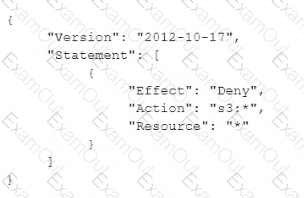A company is implementing a new application in a new IAM account. A VPC and subnets have been created for the application. The application has been peered to an existing VPC in another account in the same IAM Region for database access. Amazon EC2 instances will regularly be created and terminated in the application VPC, but only some of them will need access to the databases in the peered VPC over TCP port 1521. A security engineer must ensure that only the EC2 instances that need access to the databases can access them through the network.
How can the security engineer implement this solution?
A company became aware that one of its access keys was exposed on a code sharing website 11 days ago. A Security Engineer must review all use of the exposed access keys to determine the extent of the exposure. The company enabled IAM CloudTrail m an regions when it opened the account
Which of the following will allow (he Security Engineer 10 complete the task?
A company has an application on Amazon EC2 instances that store confidential customer data. The company must restrict access to customer data. A security engineer requires secure access to the instances that host the application. According to company policy, users must not open any inbound ports, maintain bastion hosts, or manage SSH keys for the EC2 instances.
The security engineer wants lo monitor, store, and access all session activity logs. The logs must be encrypted.
Which solution will meet these requirements?
A company hosts a public website on an Amazon EC2 instance. HTTPS traffic must be able to access the website. The company uses SSH for management of the web server.
The website is on the subnet 10.0.1.0/24. The management subnet is 192.168.100.0/24. A security engineer must create a security group for the EC2
instance.
Which combination of steps should the security engineer take to meet these requirements in the MOST secure manner? (Select TWO.)
A company hosts business-critical applications on Amazon EC2 instances in a VPC. The VPC uses default DHCP options sets. A security engineer needs to log all DNS queries that internal resources make in the VPC. The security engineer also must create a list of the most common DNS queries over time.
Which solution will meet these requirements?
A developer signed in to a new account within an IAM Organization organizational unit (OU) containing multiple accounts. Access to the Amazon $3 service is restricted with the following SCP.

How can the security engineer provide the developer with Amazon $3 access without affecting other account?
A company is running an application in The eu-west-1 Region. The application uses an IAM Key Management Service (IAM KMS) CMK to encrypt sensitive data. The company plans to deploy the application in the eu-north-1 Region.
A security engineer needs to implement a key management solution for the application deployment in the new Region. The security engineer must minimize changes to the application code.
Which change should the security engineer make to the IAM KMS configuration to meet these requirements?
A company stores sensitive data in an Amazon S3 bucket. The company encrypts the data at rest by using server-side encryption with Amazon S3 managed keys (SSE-S3). A security engineer must prevent any modifications to the data in the S3 bucket. Which solution will meet this requirement?
A security engineer for a large company is managing a data processing application used by 1.500 subsidiary companies. The parent and subsidiary companies all use AWS. The application uses TCP port 443 and runs on Amazon EC2 behind a Network Load Balancer (NLB). For compliance reasons, the application should only be accessible to the subsidianes and should not be available on the public internet. To meet the compliance requirements for restricted access, the engineer has received the public and private CIDR block ranges for each subsidiary.
What solution should the engineer use to implement the appropriate access restrictions for the application?
A company has a batch-processing system that uses Amazon S3, Amazon EC2, and AWS Key Management Service (AWS KMS). The system uses two AWS accounts: Account A and Account B.
Account A hosts an S3 bucket that stores the objects that will be processed. The S3 bucket also stores the results of the processing. All the S3 bucket objects are encrypted by a KMS key that is managed in
Account A.
Account B hosts a VPC that has a fleet of EC2 instances that access the S3 buck-et in Account A by using statements in the bucket policy. The VPC was created with DNS hostnames enabled and DNS resolution enabled.
A security engineer needs to update the design of the system without changing any of the system's code. No AWS API calls from the batch-processing EC2 in-stances can travel over the internet.
Which combination of steps will meet these requirements? (Select TWO.)

